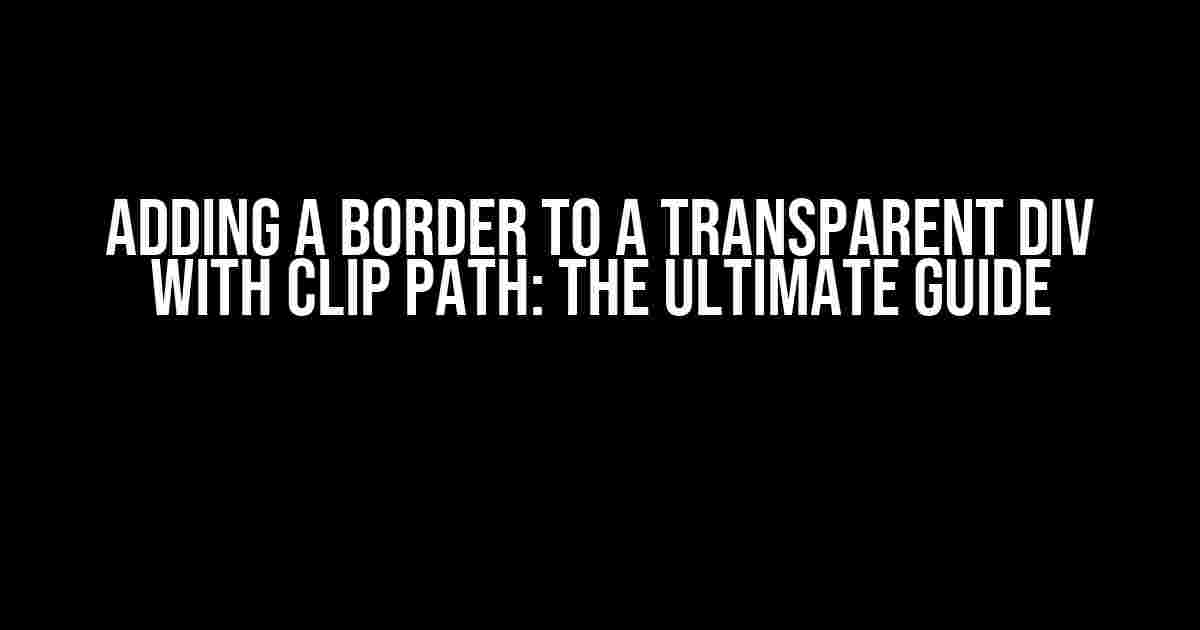Are you tired of struggling to add a border to a transparent DIV with a clip path? Do you find yourself Googling for hours, only to end up with a solution that doesn’t quite work? Fear not, dear developer, for today we’re going to dive into the world of CSS magic and uncover the secrets to adding a border to a transparent DIV with a clip path!
What is a Clip Path?
Before we dive into the tutorial, let’s quickly cover what a clip path is. A clip path is a CSS property that allows you to define a region of an element that should be visible. It’s like creating a mask that hides everything outside of the defined shape. Clip paths are often used to create complex shapes, like circles, polygons, and more.
Why is it Hard to Add a Border to a Transparent DIV with Clip Path?
The reason it’s challenging to add a border to a transparent DIV with a clip path is that the border is applied to the entire element, not just the visible region defined by the clip path. This means that if you add a border to a transparent DIV with a clip path, the border will extend beyond the visible region, creating an unwanted outline.
The Solution: Pseudo-Elements and Box-Shadows
The solution to this problem involves using pseudo-elements and box-shadows. Yes, you read that right – pseudo-elements and box-shadows! It may sound complicated, but trust us, it’s worth it.
Step 1: Create a Pseudo-Element
Create a pseudo-element using the `::before` or `::after` pseudo-element. We’ll use `::before` in this example.
.container::before {
content: "";
position: absolute;
top: 0;
left: 0;
width: 100%;
height: 100%;
clip-path: polygon(50% 0%, 100% 50%, 50% 100%, 0% 50%);
}In this example, we’re creating a pseudo-element that covers the entire container element. We’re also applying the same clip path to the pseudo-element as we would to the container element.
Step 2: Add a Box-Shadow
Now, let’s add a box-shadow to the pseudo-element to create the border effect.
.container::before {
...
box-shadow: 0 0 0 10px #000;
}In this example, we’re adding a box-shadow with a 10px spread radius, which will create a 10px border around the pseudo-element. You can adjust the spread radius to change the thickness of the border.
Adding a Border to a Transparent DIV with Clip Path: The Code
Here’s the complete code for adding a border to a transparent DIV with a clip path:
.container {
position: relative;
width: 200px;
height: 200px;
background-color: transparent;
clip-path: polygon(50% 0%, 100% 50%, 50% 100%, 0% 50%);
}
.container::before {
content: "";
position: absolute;
top: 0;
left: 0;
width: 100%;
height: 100%;
clip-path: polygon(50% 0%, 100% 50%, 50% 100%, 0% 50%);
box-shadow: 0 0 0 10px #000;
}And that’s it! You should now have a transparent DIV with a clip path and a beautiful border.
Troubleshooting Common Issues
If you’re experiencing issues with the border not displaying correctly, here are some common solutions:
- Make sure the container element has a relative position. This is essential for the pseudo-element to work correctly.
- Adjust the box-shadow spread radius. If the border is not displaying correctly, try adjusting the spread radius to see if it makes a difference.
- Check the clip path syntax. Make sure the clip path syntax is correct and that it’s applied to both the container element and the pseudo-element.
Adding a Border to a Transparent DIV with Clip Path: Examples
Here are some examples of adding a border to a transparent DIV with a clip path:
| Circle Clip Path | clip-path: circle(50% at 50% 50%); |
| Polygon Clip Path | clip-path: polygon(50% 0%, 100% 50%, 50% 100%, 0% 50%); |
| Ellipse Clip Path | clip-path: ellipse(50% 50%); |
These are just a few examples of the many clip paths you can use. Feel free to experiment and create your own unique shapes!
Conclusion
In conclusion, adding a border to a transparent DIV with a clip path may seem like a daunting task, but with the help of pseudo-elements and box-shadows, it’s a breeze! By following the steps outlined in this article, you should be able to create stunning borders for your transparent DIVs with clip paths.
Remember to troubleshoot any common issues that may arise, and don’t be afraid to experiment with different clip paths and border styles. Happy coding!
And that’s a wrap, folks! We hope you found this article informative and helpful. If you have any questions or comments, please don’t hesitate to reach out. Until next time, stay creative and keep on coding!
Here are 5 Questions and Answers about “adding a border to a transparent div with clip path”:
Frequently Asked Questions
Get the lowdown on adding a border to a transparent div with clip path – the ultimate design conundrum!
Can I add a border to a transparent div with clip path using CSS?
Absolutely! You can use the `outline` property instead of `border` to add a border to a transparent div with a clip path. The `outline` property doesn’t affect the layout, so it won’t interfere with your clip path. Just keep in mind that outlines don’t take up space, so you may need to adjust your div’s size accordingly.
How do I add a border to a transparent div with a complex clip path?
When dealing with complex clip paths, adding a border can get tricky. One solution is to duplicate the div and give the duplicate a slightly smaller size. Then, apply the border to the duplicate div and position it behind the original div using `z-index`. This will create the illusion of a border around the transparent div with a complex clip path.
Can I use a pseudo-element to add a border to a transparent div with clip path?
Yes, you can use a pseudo-element like `:before` or `:after` to add a border to a transparent div with a clip path. Apply the `clip-path` property to the pseudo-element and set its `content` to an empty string. Then, style the pseudo-element with a border and position it behind the original div using `z-index`. This will create a seamless border effect.
How do I make the border follow the shape of the clip path?
To make the border follow the shape of the clip path, you can use the `clip-path` property on the border element itself. This will ensure that the border is clipped to the same shape as the div. Alternatively, you can use an SVG border and apply the `clip-path` property to the SVG element.
Are there any browser compatibility issues with adding a border to a transparent div with clip path?
Yes, browser compatibility can be an issue when adding a border to a transparent div with clip path. Some older browsers may not support the `clip-path` property or may have limitations with pseudo-elements. Make sure to test your design across different browsers and versions to ensure compatibility.




